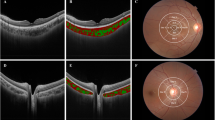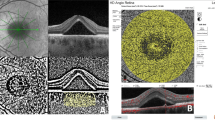Abstract
Background
To explore the relationship between the choroid vascular index (CVI) and best corrected visual acuity (BCVA) in a young population with high myopia (HM).
Subjects/Methods
Three hundred twenty-six patients with HM were recruited. All subjects underwent a comprehensive ophthalmic examination and enhanced depth imaging optical coherence tomography (EDI-OCT). The horizontal and vertical subfoveal choroidal areas within a 3-mm diameter centred over the fovea were selected. Choroid thickness (ChT), horizontal and vertical total choroidal area (TCAH and TCAV), luminal area (LAH and LAV) and stromal area (SAH and SAV) within the 3-mm diameter were assessed. CVI values (CVIH and CVIV), defined as the ratio of LA to TCA, were also calculated. The correlations among choroid parameters and ocular characteristics were analysed.
Results
The median age, spherical equivalent (SE) and BCVA were 22.4 years, −10.1 dioptres and 0.099 logMAR, respectively. The ChT was thickest on the temporal and superior sides of the macula and thinnest in the nasal region, with a significant difference. The value of CVIH was significantly greater than that of CVIV because SCAH was smaller than SCAV. Both CVIH and CVIV were closely correlated with BCVA in all patients.
Conclusions
The CVI is significantly related to BCVA but is not affected by age, axial length or SE, suggesting that the CVI could be used as an adjunct tool for assessing the visual acuity status in patients with HM.
Similar content being viewed by others
Log in or create a free account to read this content
Gain free access to this article, as well as selected content from this journal and more on nature.com
or
Data availability
The data supporting the results of the current study can be found within the article and the supplementary material.
References
Dolgin E. The myopia boom. Nature. 2015;519:276–8.
Wu PC, Chuang MN, Choi J, Chen H, Wu G, Ohno-Matsui K, et al. Update in myopia and treatment strategy of atropine use in myopia control. Eye (Lond). 2019;33:3–13. https://doi.org/10.1038/s41433-018-0139-7.
Morgan IG, French AN, Ashby RS, Guo X, Ding X, He M, et al. The epidemics of myopia: Aetiology and prevention. Prog Retin Eye Res. 2018;62:134–49. https://doi.org/10.1016/j.preteyeres.2017.09.004.
Saw SM, Matsumura S, Hoang QV. Prevention and management of myopia and myopic pathology. Invest Ophthalmol Vis Sci. 2019;60:488–99. https://doi.org/10.1167/iovs.18-25221.
Wong TY, Ferreira A, Hughes R, Carter G, Mitchell P. Epidemiology and disease burden of pathologic myopia and myopic choroidal neovascularization: an evidence-based systematic review. Am J Ophthalmol. 2014;157:9–25.e12. https://doi.org/10.1016/j.ajo.2013.08.010.
Nickla DL, Wallman J. The multifunctional choroid. Prog Retin Eye Res. 2010;29:144–68. https://doi.org/10.1016/j.preteyeres.2009.12.002.
Adhi M, Duker JS. Optical coherence tomography-current and future applications. Curr Opin Ophthalmol. 2013;24:213–21. https://doi.org/10.1097/ICU.0b013e32835f8bf8.
Margolis R, Spaide RF. A pilot study of enhanced depth imaging optical coherence tomography of the choroid in normal eyes. Am J Ophthalmol. 2009;147:811–5. https://doi.org/10.1016/j.ajo.2008.12.008.
Lee SSY, Lingham G, Alonso-Caneiro D, Chen FK, Yazar S, Hewitt AW, et al. Choroidal thickness in young adults and its association with visual acuity. Am J Ophthalmol. 2020;214:40–51. https://doi.org/10.1016/j.ajo.2020.02.012.
Ye J, Shen M, Huang S, Fan Y, Yao A, Pan C, et al. Visual acuity in pathological myopia is correlated with the photoreceptor myoid and ellipsoid zone thickness and affected by choroid thickness. Invest Ophthalmol Vis Sci. 2019;60:1714–23. https://doi.org/10.1167/iovs.18-26086.
Flores-Moreno I, Lugo F, Duker JS, Ruiz-Moreno JM. The relationship between axial length and choroidal thickness in eyes with high myopia. Am J Ophthalmol. 2013;155:314–9.e1. https://doi.org/10.1016/j.ajo.2012.07.015.
Agrawal R, Gupta P, Tan KA, Cheung CM, Wong TY, Cheng CY. Choroidal vascularity index as a measure of vascular status of the choroid: Measurements in healthy eyes from a population-based study. Sci Rep. 2016;6:21090. https://doi.org/10.1038/srep21090.
Zhao M, Alonso-Caneiro D, Lee R, Cheong AMY, Yu WY, Wong HY, et al. Comparison of choroidal thickness measurements using semiautomated and manual segmentation methods. Optom Vis Sci. 2020;97:121–7. https://doi.org/10.1097/OPX.0000000000001473.
Li Z, Wang W, Liu R, Wang D, Zhang J, Xiao O, et al. Choroidal thickness predicts progression of myopic maculopathy in high myopes: a 2-year longitudinal study [published online ahead of print, 2020 Sep 24]. Br J Ophthalmol. 2020;bjophthalmol-2020-316866. https://doi.org/10.1136/bjophthalmol-2020-316866.
Gupta P, Cheung CY, Saw SM, Koh V, Tan M, Yang A, et al. Choroidal thickness does not predict visual acuity in young high myopes. Acta Ophthalmol. 2016;94:e709–15. https://doi.org/10.1111/aos.13084.
Agrawal R, Wei X, Goud A, Vupparaboina KK, Jana S, Chhablani J. Influence of scanning area on choroidal vascularity index measurement using optical coherence tomography. Acta Ophthalmol. 2017;95:e770–5. https://doi.org/10.1111/aos.13442.
Giannaccare G, Pellegrini M, Sebastiani S, Bernabei F, Moscardelli F, Iovino C, et al. Choroidal vascularity index quantification in geographic atrophy using binarization of enhanced-depth imaging optical coherence tomographic scans. Retina. 2020;40:960–5. https://doi.org/10.1097/IAE.0000000000002459.
Kim M, Ha MJ, Choi SY, Park YH. Choroidal vascularity index in type-2 diabetes analyzed by swept-source optical coherence tomography. Sci Rep. 2018;8:70. https://doi.org/10.1038/s41598-017-18511-7.
Kim M, Kim RY, Park YH. Choroidal vascularity index and choroidal thickness in human leukocyte antigen-B27-Associated Uveitis. Ocul Immunol Inflamm. 2019;27:1280–7. https://doi.org/10.1080/09273948.2018.1530364.
Murro V, Mucciolo DP, Giorgio D, Passerini I, Cipollini F, Virgili G, et al. Choroidal vascularity index in young choroideremia patients. Retina. 2021;41:1018–25. https://doi.org/10.1097/IAE.0000000000002960.
Betzler BK, Ding J, Wei X, Lee JM, Grewal DS, Fekrat S, et al. Choroidal vascularity index: a step towards software as a medical device [published online ahead of print, 2021 Jan 29]. Br J Ophthalmol. 2021;bjophthalmol-2021-318782. https://doi.org/10.1136/bjophthalmol-2021-318782.
Ohno-Matsui K, Kawasaki R, Jonas JB, Cheung CM, Saw SM, Verhoeven VJ, et al. International photographic classification and grading system for myopic maculopathy. Am J Ophthalmol. 2015;159:877–83.e7. https://doi.org/10.1016/j.ajo.015.01.022.
Flores-Moreno I, Ruiz-Medrano J, Duker JS, Ruiz-Moreno JM. The relationship between retinal and choroidal thickness and visual acuity in highly myopic eyes. Br J Ophthalmol. 2013;97:1010–3. https://doi.org/10.1136/bjophthalmol-2012-302836.
Shao L, Xu L, Wei WB, Chen CX, Du KF, Li XP, et al. Visual acuity and subfoveal choroidal thickness: the Beijing Eye Study. Am J Ophthalmol. 2014;158:702–9.e1. https://doi.org/10.1016/j.ajo.2014.05.023.
Ding BY, Shih YF, Lin LLK, Hsiao CK, Wang IJ. Myopia among schoolchildren in East Asia and Singapore. Surv Ophthalmol. 2017;62:677–97. https://doi.org/10.1016/j.survophthal.2017.03.006.
Wang W, He M, Zhong X. Sex-dependent choroidal thickness differences in healthy adults: a study based on original and synthesized data. Curr Eye Res. 2018;43:796–803. https://doi.org/10.1080/02713683.2018.1428995.
Wong CW, Phua V, Lee SY, Wong TY, Cheung CM. Is choroidal or scleral thickness related to myopic macular degeneration? Invest Ophthalmol Vis Sci. 2017;58:907–13. https://doi.org/10.1167/iovs.16-20742.
Funding
This work was supported by the Clinical Research Plan of SHDC (SHDC2020CR2041B), the National Natural Science Foundation of China (81770944), the Foundation for the Shanghai Key Laboratory of Visual Impairment and Restoration (12DZ2260500) and the Key NHC Key Laboratory of Myopia (Fudan University), Laboratory of Myopia, Chinese Academy of Medical Sciences The sponsor or funding organization had no role in the design or conduct of this research.
Author information
Authors and Affiliations
Contributions
RY-H, ZQ-Y and QL-W designed the project; RY-H, WT-C, XY-D and QL-W were responsible for obtaining and analysing raw data. Construction of tables and figures were performed by RY-H and QL-W; RJ, QC and GZ-X supervised the complete project and validated the final results; RY-H and QL-W wrote the first draft of the manuscript. All authors have read and agreed to the published version of the manuscript.
Corresponding authors
Ethics declarations
Competing interests
The authors declare no competing interests.
Additional information
Publisher’s note Springer Nature remains neutral with regard to jurisdictional claims in published maps and institutional affiliations.
Supplementary information
Rights and permissions
Springer Nature or its licensor (e.g. a society or other partner) holds exclusive rights to this article under a publishing agreement with the author(s) or other rightsholder(s); author self-archiving of the accepted manuscript version of this article is solely governed by the terms of such publishing agreement and applicable law.
About this article
Cite this article
Han, R., Chang, W., Ding, X. et al. The choroid vascular index and its association with visual acuity in children and young adults with high myopia. Eye 37, 2542–2547 (2023). https://doi.org/10.1038/s41433-022-02369-9
Received:
Revised:
Accepted:
Published:
Issue date:
DOI: https://doi.org/10.1038/s41433-022-02369-9
This article is cited by
-
Choroidal vascularity index is independent of ocular and image-based factors in healthy eyes: a systematic review and meta-analysis
Scientific Reports (2025)
-
Quantitative evaluation of inflammation after phacoemulsification surgery: anterior chamber flare and choroidal vascular index
Japanese Journal of Ophthalmology (2025)
-
Microcirculatory parameters as risk factors for predicting progression of posterior staphyloma in highly myopic eyes: a case–control study
Eye and Vision (2024)



